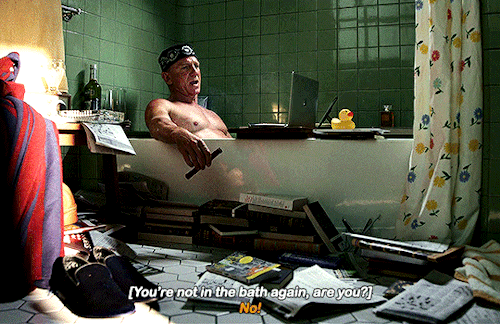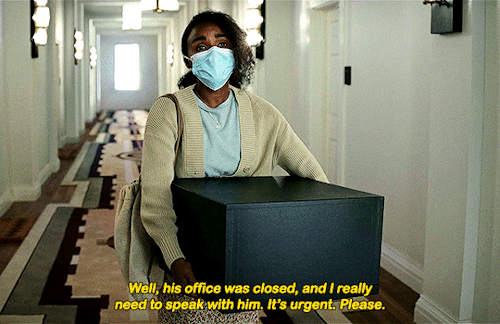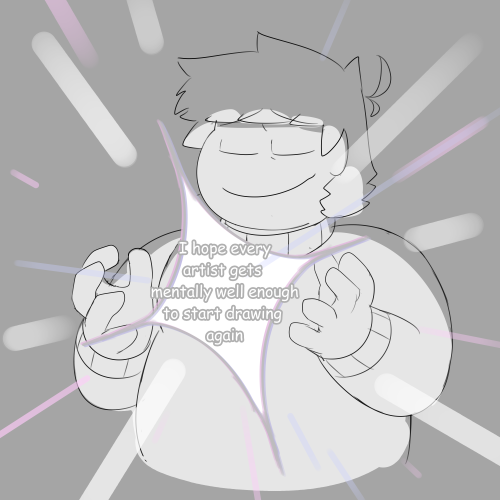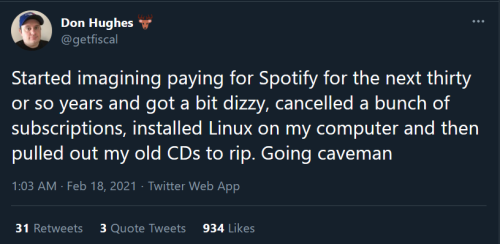“It Certainly Wasn’t Meant To Skirt Anything, But It Wasn’t Driven By COVID In Particular. It Was










“It certainly wasn’t meant to skirt anything, but it wasn’t driven by COVID in particular. It was just kind of the way the scene was written. It’s the delight of connecting up that moment, when you come back to it halfway through, with the moment from the beginning was kind of the idea of it. I felt like having Blanc be gay and have a partner just felt like a very natural thing coming out of the first movie. I feel like in general, if you think about Poirot, for example, getting glimpses of the detective’s life outside of the scope of the case is interesting. But I don’t know that I can ever see the movies being more about that. The whole thing is kind of about the mystery itself.”
— Rian Johnson on why Benoit Blanc doesn’t appear onscreen with his lover in Glass Onion
More Posts from Synth-ab and Others
Turn on "prevent third-party sharing" in your settings!
Go into your settings, click on your blog name, scroll down and enable "prevent third-party sharing". I'm gonna be honest, I question how much/if this even prevents any AI bullshit, but do it just in case anyway.

Edit: On Mobile it's the Settings Gear, Visibility, Prevent third-party sharing.
You have to turn that on for all your blogs separately.
Somewhat on the vibe of "your glorious revolution doesn't exist," I want to talk to you all, especially the young folks, about effective anarchism.
Spoiler alert, it's not blowing stuff up or arson.
I am considered the most anarchical person of all among my friends. Granted, most of my experience has been wreaking anarchy against the systems present in my high school and college, but the principles are the same.
Practical anarchy is not the big, flashy, romanticizable thing people online make it out to be. It's more about the long haul - digging in your teeth and just being a menace that no one can really get rid of.
Everyone's "Why vote when you can firebomb a Walmart" posts (that they don't follow through on) are just not pratical because this is a surveillance society. With CCTV and DNA testing and cell phone cameras and GPS tracking, if you do something big like that, you are GOING to be caught; then that is the end of your anarchical career. And, keep in mind that you might get caught while you're setting up this big event - it's a crime to blow up a Walmart and also a crime to conspire to blow up a Walmart, so your career in anarchy might end before it begins, and then you are permanently out of the game. No matter what causes you were working for that inspired you to do something big and violent that you thought would get someone's attention, you now can't help at all ever again in your entire life. What you did will be a passing headline on the news, and then everything will go back to exactly what it was because big, acute actions can't compare in effectiveness to small, constant actions (just being a thorn in the side of the system, poking and poking, but unable to be dislodged).
This is just the practical side of it too: think about the risk of hurting innocents if you really advocate for doing things like that. You think blowing up a Walmart would really make a dent in that big of a corporation? But if you intentionally or unintentionally kill a bunch of Walmart shoppers, that's going to devastate families that had nothing to do with whatever your cause is.
So all that big talk about violence and destruction: not practical, not effective, not ethical.
The only way I've started to change oppressive systems around me is by justing chipping away from within the confines of the rules of these systems, and/or only stepping just outside them (never breaking rules in a big way that could have allowed said system to easily and "justifiably" get rid of me).
So if you're going to be an anarchist, you need to consider:
Having the longest career in anarchism possible (i.e. being careful enough and judicious with your actions so that you don't get expelled from the system you wish to fight).
And then for any given anarchical plan:
2. Potential consequences.
3. Insurance.
I'll give you an example. I had serious beef with the culture of my college's science department. Students were constantly overworked, and if they expressed their misery outloud or reached out to any of their professors about their struggles, they got apathetic responses if not direct insults to their abilities or dedication. I had too many similar disparaging interactions with professors in one week, and I realized a lot of the responses I was getting were just the result of professors not really knowing how they sounded when they said certain things to students (ex: If someone says they're struggling with a course, don't IMMEDIATELY respond with "change your major," - you can give that as an option, but if you make it your first suggestion, the implication to the student is that if they're having any trouble with the course, they're not good enough for the program).
So I wrote up a flier of examples of good and bad ways to respond to students having anxiety with explanations and distributed it to every professor in the department. Everyone who knew about this perceived it as a great personal risk - that I would get in some kind of unspecified trouble or piss off an important professor, so before embarking on this project, I considered...
Potential consequences: I couldn't really think of any specific college or department rules I could be violating. People postered and handed out fliers in the department all the time. What I was doing fell pretty clearly under freedom of speech. I just shoved the fliers under professors' doors, so I didn't trespass in anyone's office. Worst I could think is that individual professors would get mad at me and make my life difficult, or I'd simply be told to stop fliering in the department.
Insurance: Just in case there were any consequences that I didn't think of and to insure me against the ones I had thought of, I didn't put my name on the flier. It was typed in Word, something everyone had access to. I came in to do it after professors had all left for the day but before I needed to use my ID to get into the building (no electronic record of me being there). I took the elevator to the first floor offices because the stairs require ID swipe after 5pm, but the elevators do not. I found out the building had no cameras by asking about it on the grounds that something of mine had been stolen a few weeks prior. I shoved the flier under the doors of dark offices and left it outside offices with lights on (so that no one would come out and spot me). And here's one of the most important pieces of insurance: I put up a few of the fliers on public bulletin boards in the building. This was important so that if I slipped up and said something that conveyed that I had knowledge of the content of the flier, I would have an excuse for that, i.e., I read it on the bulletin board before class this morning.
And then I did the thing. And surprisingly, it was incredibly well-received by professors. A few who knew that the flier must have been mine (because of previous, similar anarchical actions rumored to be associated with me) told me that everyone was RELIEVED that they finally had an instruction manual from the student perspective on what the hell they're supposed to say when one of their students is panicking. It sparked a real change in the vibe of the department and student experience. Had it instead pissed people off, I would have simply said I could not claim authorship of the flier but had read it and thought it contained good ideas then gone on creating more anarchy while angry people grasped at the zero straws I had left them to pin the action on me.
That's an example of a single action I took that was part of a much longer (~3 years) campaign of mine to change the culture of my department. Everytime I did something in that campaign, I made that consequences vs. insurance calculation to make sure they couldn't expell me from the program, the department, or the school before I succeeded.

Zelink is taking over my brain again
Hey y’all I’ve been looking through the Goncharov (1973) posts, and it seems like most people aren’t aware of the master document, which has all the lore, behind the scenes, and plot breakdown. It’s collaborative, so we can all make sure we get the most accurate depiction of everyone’s favorite movie :)

I’m so sorry if you’ve already answered this somewhere, but how do you design your characters?
I’ve been trying to make an OC from the prohibition era and it turns out there’s basically nothing to work with for men’s outfits, so I’m curious how you made this many that look unique and fitting to the characters
There is so much to work with, though! You will tend to find more of a focus on variety in women's fashion, but there is still quite a lot of menswear to ogle too. I suppose it's just a matter of searching out ideas and inspiration in the rights corners. Here are a few suggestions:
Old Clothing Catalogues -
Collections from Sears-Roebuck and other popular clothing retailers are pretty easy to find compiled into relatively inexpensive books, or just floating online.

A fair bit of it is in the public domain now.
--Here's an entire 1922 catalogue of stuff to flip through.
-----------------
Contemporary Artwork -
Some phenomenal illustrators were working in this field amidst the "Golden Age of Illustration" and featured prominently on the covers of magazines and on the ads inside. There was a lot of emphasis on fashion.

Collier's and The Saturday Evening Post are a couple of the more prominent and easily searchable resources. The costuming on the cover art always has a lot of personality.

There's Rockwell, of course, and it's almost impossible to go wrong with J. C. Leyendecker. He's probably best known for his Arrow Collar ad art, but even his sock ads are like…

There were numerous other amazing and influential illustrators working at the time too. Here's a list of some of them. Here's a bonus Henry Raleigh featuring some of his fabulously-dressed people.

-----------------
Blogs and Articles -
There are so many of them! If you want historical accuracy, be wary of write-ups pulling all of their references from film and television. There's nothing wrong with using those for inspiration if you aren't too concerned with historicity, but there are some pretty comprehensive and well-researched things out there with more of an eye on actual fashion history too:
--Gentleman's Gazette - What Men Really Wore in the 1920s
--The Fashionisto - 1920s Men's Fashion
-----------------
Digital Collections -
There are numerous digital historic image collections stemming from universities, museums, libraries, and the government that are free to peruse too.
--The Metropolitan Museum has a searchable catalog of exhibits that includes fashion and photos
--Here's some things from the New York Public Library
-----------------
Photos at Large -
If you aren't sure where to start, image searching for any of Hollywood's early celebrities will typically turn up a bevy of production stills and promotional photography featuring a variety of fashions. Here's a random Getty images search for Harold Lloyd. A lot of standard 3 piece suits, but a lot of stuff with added character too.

Photography was generally quite accessible by the 1920s, though, and you can find a lot of authentic photos of people from all walks of life, out in the wild wearing all sorts of clothes.

This is by no means the limit to the resources available, but hopefully it'll provide some leaping-off points for designing looks for your characters!
My DnD character, Soolian. He's a fancy lad and also 24/7 stressed out of his mind


Like to charge, reblog to cast

you’re hearing it more and more

A quick study from a screenshot of « the case of the gilded Lily ».

-
 trappedinsideabubble liked this · 1 month ago
trappedinsideabubble liked this · 1 month ago -
 bluesky197 reblogged this · 2 months ago
bluesky197 reblogged this · 2 months ago -
 bluesky197 liked this · 2 months ago
bluesky197 liked this · 2 months ago -
 warcriminalr2d2 liked this · 4 months ago
warcriminalr2d2 liked this · 4 months ago -
 makesitprecious reblogged this · 4 months ago
makesitprecious reblogged this · 4 months ago -
 makesitprecious liked this · 4 months ago
makesitprecious liked this · 4 months ago -
 daylewiz reblogged this · 5 months ago
daylewiz reblogged this · 5 months ago -
 daylewiz liked this · 5 months ago
daylewiz liked this · 5 months ago -
 solarianloverboi liked this · 5 months ago
solarianloverboi liked this · 5 months ago -
 littlelemonme reblogged this · 6 months ago
littlelemonme reblogged this · 6 months ago -
 captainmerlock reblogged this · 6 months ago
captainmerlock reblogged this · 6 months ago -
 captainmerlock liked this · 6 months ago
captainmerlock liked this · 6 months ago -
 urbestnightmare4322 liked this · 7 months ago
urbestnightmare4322 liked this · 7 months ago -
 silentmistynight liked this · 7 months ago
silentmistynight liked this · 7 months ago -
 ghostsinthecellar reblogged this · 7 months ago
ghostsinthecellar reblogged this · 7 months ago -
 fvckw4d liked this · 7 months ago
fvckw4d liked this · 7 months ago -
 shewhowatchestoomuch reblogged this · 7 months ago
shewhowatchestoomuch reblogged this · 7 months ago -
 atethys reblogged this · 8 months ago
atethys reblogged this · 8 months ago -
 permanenthistorydamage liked this · 8 months ago
permanenthistorydamage liked this · 8 months ago -
 boviform reblogged this · 8 months ago
boviform reblogged this · 8 months ago -
 nil-me-chuchulainn liked this · 8 months ago
nil-me-chuchulainn liked this · 8 months ago -
 grimsgrumbles liked this · 8 months ago
grimsgrumbles liked this · 8 months ago -
 marbarinthebar liked this · 8 months ago
marbarinthebar liked this · 8 months ago -
 zonkutonshorrifyingpeenie reblogged this · 8 months ago
zonkutonshorrifyingpeenie reblogged this · 8 months ago -
 smallmilo reblogged this · 8 months ago
smallmilo reblogged this · 8 months ago -
 tired-yeetling liked this · 8 months ago
tired-yeetling liked this · 8 months ago -
 alexgorl liked this · 8 months ago
alexgorl liked this · 8 months ago -
 lavendertownsghost reblogged this · 8 months ago
lavendertownsghost reblogged this · 8 months ago -
 lavendertownsghost liked this · 8 months ago
lavendertownsghost liked this · 8 months ago -
 follow-like-reblog liked this · 8 months ago
follow-like-reblog liked this · 8 months ago -
 gnomedyke liked this · 8 months ago
gnomedyke liked this · 8 months ago -
 asinglemagpie reblogged this · 8 months ago
asinglemagpie reblogged this · 8 months ago -
 mole-from-atlantis liked this · 8 months ago
mole-from-atlantis liked this · 8 months ago -
 graduatedpillowmonster liked this · 8 months ago
graduatedpillowmonster liked this · 8 months ago -
 name-here-or-something-idk liked this · 8 months ago
name-here-or-something-idk liked this · 8 months ago -
 lux-et-astra liked this · 8 months ago
lux-et-astra liked this · 8 months ago -
 annoyeddeadartist liked this · 8 months ago
annoyeddeadartist liked this · 8 months ago -
 maxi-multiverse reblogged this · 8 months ago
maxi-multiverse reblogged this · 8 months ago -
 a-magical-boy liked this · 8 months ago
a-magical-boy liked this · 8 months ago -
 silastheanon reblogged this · 8 months ago
silastheanon reblogged this · 8 months ago -
 silastheanon liked this · 8 months ago
silastheanon liked this · 8 months ago -
 nonbinarymissingno reblogged this · 8 months ago
nonbinarymissingno reblogged this · 8 months ago -
 cat-bottom liked this · 8 months ago
cat-bottom liked this · 8 months ago -
 dragonheart905 liked this · 8 months ago
dragonheart905 liked this · 8 months ago -
 hellishgayliath liked this · 8 months ago
hellishgayliath liked this · 8 months ago -
 igiveinyouhellsite liked this · 8 months ago
igiveinyouhellsite liked this · 8 months ago -
 leajamjam reblogged this · 8 months ago
leajamjam reblogged this · 8 months ago -
 leajamjam liked this · 8 months ago
leajamjam liked this · 8 months ago -
 professionallydeadinside reblogged this · 8 months ago
professionallydeadinside reblogged this · 8 months ago -
 the-sub-orbital-warlock reblogged this · 8 months ago
the-sub-orbital-warlock reblogged this · 8 months ago

Eternal Lurker, finally here - they/them - art only account : @synth-art - 🔵blueskye account : synthab.bsky.social
154 posts